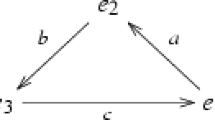Abstract
We introduce two partially overlapping classes of pathwise dualities between interacting particle systems that are based on commutative monoids (semigroups with a neutral element) and semirings, respectively. For interacting particle systems whose local state space has two elements, this approach yields a unified treatment of the well-known additive and cancellative dualities. For local state spaces with three or more elements, we discover several new dualities.
Similar content being viewed by others
Data Availability
Data sharing is not applicable to this article as no datasets were generated or analysed during the current study.
Notes
Note that the functions \(\psi (\,\cdot \,,y)\) with y ranging through R are trivially all different from each other, since \(R\ni y\mapsto f_y\in {{\mathcal {H}}}(S,T)\) is an isomorphism.
References
Bramson, M., Ding, W., Durrett, R.: Annihilating branching processes. Stoch. Process. Appl. 37, 1–17 (1991)
Cox, J.T., Durrett, R.: Nonlinear voter models. In: Random Walks, Brownian Motion and Interacting Particle Systems. A Festschrift in Honor of Frank Spitzer, pp. 189–201. Birkäuser, Boston (1991)
Carinci, G., Giardinà, C., Giberti, C., Redig, F.: Dualities in population genetics: a fresh look with new dualities. Stoch. Process. Appl. 125(3), 941–969 (2015)
Clifford, P., Sudbury, A.: A sample path proof of the duality for stochastically monotone Markov processes. Ann. Probab. 13, 558–565 (1985)
Forsythe, G.: SWAC computes 126 distinct semigroups of order 4. Proc. Am. Math. Soc. 6(3), 443–447 (1955)
Giardinà, C., Kurchan, J., Redig, F., Vafayi, K.: Duality and hidden symmetries in interacting particle systems. J. Stat. Phys. 135(1), 25–55 (2009)
Griffeath, D.: Additive and cancellative interacting particle systems. In: Lecture Notes in Math, vol. 724. Springer, Berlin (1979)
Handjani, S.J.: The complete convergence theorem for coexistent threshold voter models. Ann. Probab. 27(1), 226–245 (1999)
Jansen, S., Kurt, N.: On the notion(s) of duality for Markov processes. Prob. Surv. 11, 59–120 (2014)
Krone, S.M.: The two-stage contact process. Ann. Appl. Probab. 9(2), 331–351 (1999)
Liggett, T.M.: Interacting Particle Systems. Springer, New York (1985)
Liggett, T.M.: Stochastic Interacting Systems: Contact, Voter and Exclusion Processes. Springer, Berlin (1999)
OEIS Foundation Inc. Entry A058131 In: The On-Line Encyclopedia of Integer Sequences (2022). http://oeis.org/A058131
Sudbury, A., Lloyd, P.: Quantum operators in classical probability theory. II: the concept of duality in interacting particle systems. Ann. Probab. 23(4), 1816–1830 (1995)
Sturm, A., Swart, J.M.: Voter models with heterozygosity selection. Ann. Appl. Probab. 18(1), 59–99 (2008)
Sturm, A., Swart, J.M.: Pathwise duals of monotone and additive Markov processes. J. Theor. Probab. 31(2), 932–983 (2018)
Sturm, A., Swart, J.M., Völlering, F.: The algebraic approach to duality: an introduction. In: M. Birkner (ed.) et al., Genealogies of Interacting Particle Systems. World Scientific. Lect. Notes Ser., Inst. Math. Sci., Natl. Univ. Singap. 38, pp. 81–150 (2020)
Sudbury, A.: Dual families of interacting particle systems on graphs. J. Theor. Probab. 13(3), 695–716 (2000)
Swart, J.M.: Duality and Intertwining of Markov Chains. Lecture notes for the ALEA in Europe school, Luminy, Oct 21–25, 2013. Available at: http://staff.utia.cas.cz/swart/tea_index.html
Acknowledgements
Work was supported by Grant 20-08468S of the Czech Science Foundation (GAČR)
Author information
Authors and Affiliations
Corresponding author
Additional information
Publisher's Note
Springer Nature remains neutral with regard to jurisdictional claims in published maps and institutional affiliations.
A Appendix
A Appendix
1.1 A.1 Addition Tables of Commutative Monoids of Order Four

1.2 A.2 Duality Functions for Commutative Monoids of Order Four

1.3 A.3 Multiplications in Semirings of Cardinality Four

Rights and permissions
Springer Nature or its licensor holds exclusive rights to this article under a publishing agreement with the author(s) or other rightsholder(s); author self-archiving of the accepted manuscript version of this article is solely governed by the terms of such publishing agreement and applicable law.
About this article
Cite this article
Latz, J.N., Swart, J.M. Commutative Monoid Duality. J Theor Probab 36, 1088–1115 (2023). https://doi.org/10.1007/s10959-022-01197-7
Received:
Revised:
Accepted:
Published:
Issue Date:
DOI: https://doi.org/10.1007/s10959-022-01197-7




